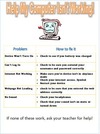
Troubleshooting Anchor Chart for Students
- Subject:
- Computing Systems
- Material Type:
- Student Guide
- Author:
- Christopher McElraft
- Date Added:
- 04/18/2022

Troubleshooting Anchor Chart for Students

Computer Use Agreement for Second Grade2.9 The student will explain what is allowed and what is not allowed at school associated with the use of technology (e.g., class rules).

Students will come to understand how their own brains can be similar to computers. People tend to be left-brain or right brain dominant; however, with tools and training, non-dominant characteristics can be enhanced much to that of computers that are outfitted with hardware and software for gaming versus designing. This lesson will focus on input and output devices to graph equations written in the form y = mx+b.
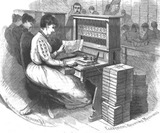
This is a reference resource on the timeline of computers from the 1800's to the present. It contains two graphic images from the g2.com website showing the history of computers from 1890 to the 1970's and from 1980 to 2015 as well as a link to the website that provides more details of the items from the charts. Weblink to article

For this lesson it is important that students have seen and/or used a computer to be able to discuss the differences and similarities of computers from the past and present. While looking at computers and their systems students will be discussing the things that computers do to make their lives easier and the ways that they use computers everyday in their daily lives.

The student (grades 4-7) will read the article and determine the purposes of each of the nine (simplified) tasks of a computer's operating system. This can be an independent, small group, or whole group activity.

At the start of this lesson, the students will meet with the teacher as a whole group on the carpet. The teacher will display a Google Slide presentation about computing systems. The lesson will start with a small discussion about the purpose of computers. After activating their prior knowledge, the students will watch a short video about the different types of computers and the parts that make up a computer. Afterwards, the students will review what they learned by identifying the different types of computers using pictures and naming the different parts of a computer by listening to clues about their function. Once the students understand the information, the teacher will have the students return to their desks and complete a worksheet where they will identify the items that rEnglishte to a computer.

The teacher will help students identify, compare, and contrast different computing systems such as a desktop computer, laptop computer, tablet, and mobile device; identify and describe the purpose of the keyboard, mouse/trackpad, and printer. This lesson would go well before students use their devices for the first time!

This resource an inforgraphic that talks about includes Charles Babbage, Ada Lovelace, Alan Turing, Grace Hopper, and Tim Berners-Lee. These are the significant historical figures listed in the Middle School Elective Curriculum Framework, MSCSE.6, context of the standard.
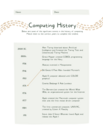
This worksheet reviews some of the significant events in computing history. Students will draw lines to connect the person/event to the time it occured.
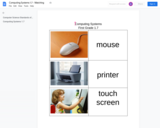
This document is intended to be used for small group discussion, personal or partner matching or memory game, and review of previously taught components.
Included are 8 picture and label cards containing desktop computer, laptop, tablet, mouse, keyboard, mobile devices, printer, and touch screen.
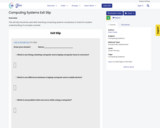
This exit slip should be used after teaching computing systems vocabulary to check for student understanding of concepts covered.
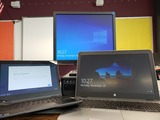
This slides presentation has a short video about the 4 things that all computing devices have in common and then has picture examples of Input and output devices. It also has a slide of internal components we don't usually see.The final slide is a sorting activity that includes input and output devices.
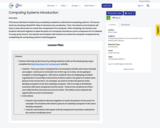
This lesson will teach students key vocabulary needed to understand computing systems. The lesson starts by showing a BrainPOP video to introduce key vocabulary. Then, the teacher and students will have a class discussion to review the components of a computer. After reviewing, the teacher and students will work together to label the parts of a computer and discuss each component as it is labeled. To wrap up the lesson, the teacher and students will continue to review the computer components by completing the computing systems matching game.
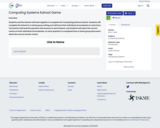
Students and the teacher will work together to complete the Computing Systems Kahoot. Students will complete the Kahoot in a whole group setting, but will have their individual chromebooks to work from. The teacher will read the question and answers to each Kahoot, and students will select the correct choice on their individual chromebooks. As each question is completed have a whole group discussion about the correct answer choice.
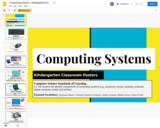
This is a set of printable classroom posters with images and basic terminology for kindergarten students.
The terminology covered is as follows:
Keyboard
Mouse
Trackpad
Desktop computer
Laptop computer
Mobile Device
Tablet
Printer
You may make a copy of the posters. Please feel free to add any additional information or edit the slides to best suit your student's needs.

This lesson will teach students key vocabulary needed to understand computing systems. The lesson starts by showing a video to introduce key vocabulary terms. Then, teacher and students will have a class discussion to review components of a computer, hardware/software and input/output, and how to resolve problems when using a device. Teacher will facilitate a Kahoot, and students will answer each question individually to review material learned throughout the lesson. To wrap up the lesson, students will be asked to complete an exit slip by matching pictures to the correct terms (hardware, software, input, output).

Teachers read aloud an eBook about computer systems. Teacher guide includes questioning activities and suggested follow-ups for after reading.

Students will be challenged with researching various problems that may occur with hardware and software for computer usage and then turn their research into posters for the class to use later if they have a problem occur past our lesson.

These slides contant the vocabulary from the Virgnia Department of Education for the Computing Systems strand.